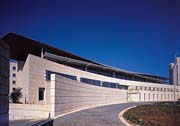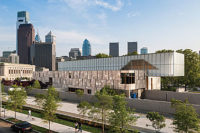
Within the city of Jerusalem, Israel, the region’s native limestone has been a constant staple for building design over the years. It is a characteristic of the city that has created continuity throughout the community, and creating a building to fit its Middle Eastern setting is an important part of the process. One of these newly built structures in Jerusalem is the Foreign Ministry building located in the Kiryat Ben-Gurion (the government complex) near the Knesset. Sustaining the rich tradition, the facility was designed with Ramon Yellow limestone from Israel.
To create a suitable home for the Ministry of Foreign Affairs, the new Foreign Ministry building had to be developed with a friendly aesthetic but protected with the security of a fortress. “The overall design goal of the project was to make a place that the nation would be proud of,” said Architect Jack Diamond of Diamond and Schmitt Architects Inc., in Toronto, Canada. “Because the building represents the state, it is important that the public’s impression of the building is welcoming and attractive.”
While the architects wanted to be sure that the Foreign Ministry building would blend with its surroundings, they also sought to give its own identity. This was accomplished by avoiding any building products other than the traditional materials used in the city, according to Diamond.
The architects considered many different stones before a final decision was made. “The first preference that we had was a salmon-colored stone, Slaib, but only a limited amount was available,” said Diamond. “Other stones in the running were almost white in color,” explained architect Randy Epstein of Kolker Kolker Epstein Architects of Jerusalem, Israel. “We wanted a stone that had more character and would distinguish itself from more common stones. We looked for a stone finish and detail that would relate to the traditional stone use, but contemporary expression.” In addition to meeting aesthetic and quality requirements, the stone also had to fit within the budget for the project.
Accommodating all of these elements, the stone supplier and installer, Arik Grebelsky, of Jerusalem Marble A. Grebelsky Co. decided on Ramon Yellow limestone. Quarried in Mizpe Ramon, set in the Negev region of Israel, 200,000 square feet of stone was needed to complete this architectural composition, so Grebelsky said 300,000 square feet of stone was cut for the project. With the sand, light and other natural surroundings of the building, a gold tone is cast on the structure. Architects were interested in getting a uniformed gold color for the stone. This unique characteristic of the Ramon yellow limestone really proved its appropriateness for the new building. “It looked great in the low Jerusalem sun,” said Epstein.
After Ramon Yellow limestone was chosen for the majority of the project, the next task was to implement a very unique chiseled finish. “The buildings in the city of Jerusalem built from stone, are usually clad with a chiseled stone made by hand,” said Grebelsky. “For this building, the architects wanted to use big pieces of stone that were difficult to chisel by hand. They chose to use a machine chisel finish. Another reason for using the machine finish was to create a building that will combine modern and tradition. The architects spent a lot of time in the factory working on the chiseling machine until they found the right fine chiseled finish. This finish that looked new or even strange in the beginning became very popular. Other projects are being completed with the fine chiseled finish.”
The architects of the building agreed with the choice that the supplier selected. “Overall, the look of the finish and stone that we were going for was a sophisticated rustication,” explained Epstein. “The beauty of the finish is that it is rough enough to fit the scale of the outside, but not too rough. When you are up against it, it is still ‘touchable.’ On the outside, we give a different scale by setting back a 2-inch strip, every two rows. The strips that are set back, are only in the ‘landscape’ walls. Other than these walls, all inside and outside walls are finished exactly the same.”
A particular system of installation was used. “Installing the stone was done very differently than it is done in the U.S.,” said Grebelsky. “A system called the ‘wet system’ was used, as opposed to the ‘dry system.’ After the concrete wall is in place, the stone installer places four holes in every stone. After that, we attach the net to the wall with a metal wire, and the cement provides adhesion. The stone is now a part of the wall.”
In addition to the Ramon Yellow limestone, 7,535 square feet of onyx was specified for the four large walls of the ceremonial lobby. The outside walls of the formal reception hall were made of translucent onyx that diffuses an amber light. “The onyx was chosen because it is light in color and transmits light as well,” said Epstein. “During the day, from the outside, it looks like the Jerusalem Gold stone adjacent to it, and at night it glows.” To make sure that onyx was correctly chosen, Epstein flew to China to inspect the stone where it was quarried and cut.
Beginning the project in 1998 and finishing up in February of 2003, the architects did stumble upon a few challenges during the five years of construction. “Getting the onyx at all -- both in terms of budget and in terms of safety -- was a difficulty we encountered,” explained Epstein, who added that providing security within the building’s structure was another challenge. “The building was designed to protect the people within in the event of an explosion.”
Now that the building is complete, it has been hailed as a success. “The project has created a new standard for stone in Jerusalem,” according to Epstein. “The reaction has been good.” With this positive feedback, the Foreign Ministry building has become a new landmark in the national precinct.

End box
Foreign Ministry Building, Jerusalem, Israel
Architects: Diamond and Schmitt Architects Inc., Toronto, Canada; Kolker Kolker Epstein Architects, Jerusalem, IsraelStone Supplier/Installer: Jerusalem Marble A. Grebelsky Co., Jerusalem, Israel
